
Linn County is a county located in east-central Kansas and is part of the Kansas City metropolitan area. As of the 2010 census, the county population was 9,656. Its county seat is Mound City, and its most populous city is Pleasanton. The county was named for Lewis F. Linn, a U.S. Senator from Missouri.

This is a list of sites in Minnesota which are included in the National Register of Historic Places. There are more than 1,700 properties and historic districts listed on the NRHP; each of Minnesota's 87 counties has at least 2 listings. Twenty-two sites are also National Historic Landmarks.
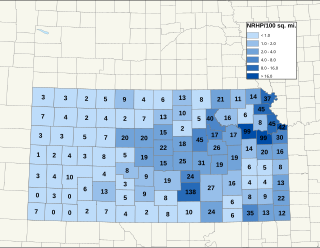
There are over 1,400 buildings, sites, districts, and objects in Kansas listed on the National Register of Historic Places in Kansas. NRHP listings appear in 101 of the state's 105 counties.

James Barney Marsh was an American engineer and bridge designer. He patented a new design for arch bridges. Marsh gave Archie Alexander, the first African-American to graduate as an engineer from the University of Iowa, his first job. Marsh worked in the bridge building business for over 50 years, and several of his bridges are listed in the National Register of Historic Places.

This is intended to be a complete list of the properties and districts on the National Register of Historic Places in Fairfield County, Connecticut, United States. The locations of National Register properties and districts for which the latitude and longitude coordinates are included below may be seen in an online map.
The Kansas City Bridge Company was a bridge building company that built many bridges throughout the Midwest United States in the early 1900s. The company was founded in 1893 and ceased business around 1960.

The County Line Bowstring is a bridge located near unincorporated Hollis, Kansas, United States, that is listed on the National Register of Historic Places. It spans West Creek on the border between Cloud and Republic counties and has a wooden deck with a bowstring pony truss.
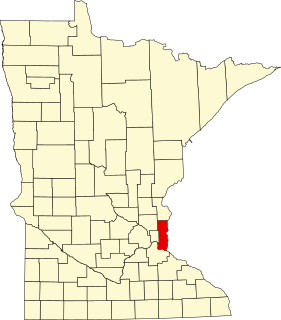
This is a list of the National Register of Historic Places listings in Washington County, Minnesota. It is intended to be a complete list of the properties and districts on the National Register of Historic Places in Washington County, Minnesota, United States. The locations of National Register properties and districts for which the latitude and longitude coordinates are included below, may be seen in an online map.

This is a list of the National Register of Historic Places listings in Koochiching County, Minnesota. It is intended to be a complete list of the properties and districts on the National Register of Historic Places in Koochiching County, Minnesota, United States. The locations of National Register properties and districts for which the latitude and longitude coordinates are included below, may be seen in an online map.

This is a list of the National Register of Historic Places listings in Lac qui Parle County, Minnesota. It is intended to be a complete list of the properties and districts on the National Register of Historic Places in Lac qui Parle County, Minnesota, United States. The locations of National Register properties and districts for which the latitude and longitude coordinates are included below, may be seen in an online map.

The Marais des Cygnes Massacre Site, also known as Marais des Cygnes Massacre Memorial Park, is a state historic site near Trading Post, Kansas that commemorates the 1858 massacre of the same name. On May 19, 1858, during a period of political instability and sporadic violence known as Bleeding Kansas, a group of pro-slavery border ruffians captured 11 abolitionist free-staters. The prisoners were forced to a nearby ravine, where 10 of them were shot, resulting in five fatalities. The abolitionist John Brown later built a fort near the site. The first commemoration at the site was two stone markers erected by men of the 3rd Iowa Cavalry Regiment in 1864, although these monuments had been destroyed by souvenir hunters by 1895. In 1941, the land where the massacre occurred, as well as an 1870s-era house constructed by a friend of Brown, were transferred to the state of Kansas. The site was listed on the National Register of Historic Places in 1971 and designated a National Historic Landmark in 1974. The Kansas Historical Society administers the site, which is interpreted by signage and a hand-cranked audio recording.

The Waddell "A" Truss Bridge, also known as Linn Branch Creek Bridge, is a historic truss bridge located at Parkville, Platte County, Missouri. It was built in 1898. It was designed by engineer John Alexander Low Waddell and is the subject of U.S. Patent 529,220.

The Miami County Courthouse, located east of the junction of Miami and Silver Streets in Paola, is the seat of government of Miami County, Kansas. The courthouse was built from 1898 to 1899 and has housed the county's government ever since. Architect George P. Washburn designed the courthouse; its design is Victorian with Romanesque Revival details. The building features a tower at each corner; the southwest tower was once a clock tower but no longer has a clock. The east and west entrances to the courthouse feature porches with brick columns. The upper windows of the building are arched with stone; the stone continues around the building in a band, a feature described as "one of the strongest elements of the [building's] design". The courthouse's roof incorporates a variety of designs; the main part of the roof and the towers are hipped, while gable ends are located between the towers.

The Franklin County Courthouse, located in Courthouse Square on Main Street in Ottawa, is the seat of government of Franklin County, Kansas. The courthouse was built in 1892. Although Ottawa had been the county seat since 1864, it lacked a permanent courthouse prior to then. Architect George P. Washburn designed the courthouse in the Romanesque Revival style; the red brick courthouse is considered one of Washburn's "most outstanding works". The design features four square corner towers, a typical feature of Washburn's designs; two cupolas on the roof include a bell tower and a clock tower. The intricate roof design includes a main hipped roof with gable ends on each side and steep hipped roofs atop the towers. The roof line is ridged with a metal spine, and a dentillated cornice runs beneath the roof's edge. The east and west entrances to the courthouse are through large porches supported by brick columns and topped with balconies. The second-story windows are arched and connected by a band of stone.
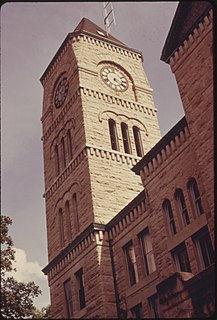
The Atchison County Courthouse, located at the southwest corner of 5th and Parallel Streets in Atchison, is the seat of government of Atchison County, Kansas. The stone courthouse was built from 1896 to 1897 and replaced the county's first courthouse, which had been built in 1859. County officials wanted the courthouse to resemble the Franklin County Courthouse in Ottawa, so they hired that building's architect, George P. Washburn, to design the new courthouse. Washburn designed the building in the Romanesque Revival style. The courthouse's design features four corner towers, including a seven-story clock tower. The main entrance to the courthouse has a porch within a large arch; the doorway is contained in a smaller arch. The building has a hip roof with intersecting gable dormers; the towers have pyramidal roofs.
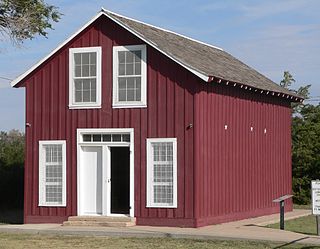
The Pond Creek Station, located east of Wallace on US 40, in Wallace County, Kansas, is a two-story frame building that was a stagecoach station built 1865. It is believed to be the oldest manmade structure in northwest Kansas and to be the only Butterfield Overland Dispatch stage company building surviving in Kansas. It was listed on the National Register of Historic Places in 1972.

Papinville Marais des Cygnes River Bridge, is a historic Pinned Pratt through truss located at Papinville, Bates County, Missouri. It was built in 1884 by the Kansas City Bridge and Iron Co. and spans the Marais des Cygnes River. It is a three span bridge with a central Pratt truss measuring 116 feet and two connected Warren-pony truss spans. It rests on stone abutments with concrete and steel piers and measures a total 234 feet long.

The Old Linn County Jail, also known as City Hall, at 312 Main Street in Mound City in Linn County, Kansas was built in 1867–68. It was listed on the National Register of Historic Places in 1978.

The Landers Creek Bridge, also known as the Goodrich Bridge and located at the southern edge of Goodrich in Linn County, Kansas, is a stone arch bridge which was built in 1917. It was listed on the National Register of Historic Places in 1985.
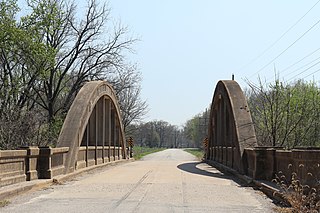
The Mine Creek Bridge, located east of Mound City in Linn County, Kansas, was built in 1927. It was listed on the National Register of Historic Places in 1983.


























